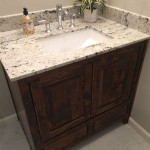Corner Mount Bathroom Sinks: A Comprehensive Guide
Corner mount bathroom sinks offer a space-saving solution for smaller bathrooms, powder rooms, or any area where maximizing floor space is a priority. Their unique design allows them to fit snugly into a corner, freeing up valuable square footage and creating a more open and airy feel. This article delves into the various aspects of corner mount bathroom sinks, covering their advantages, types, installation considerations, and maintenance to provide a comprehensive understanding of this space-efficient fixture.
Before the widespread adoption of minimalist designs and space-conscious living, bathroom fixtures were often bulky and inefficient in their footprint. Corner sinks represent a shift towards more practical and aesthetically pleasing solutions for limited spaces. The historical development included initial adaptations of wall-mounted sinks to fit corners, evolving into specialized designs tailored for optimal usability within the constraints of a 90-degree angle.
The fundamental purpose of a corner sink remains the same as any other sink: providing a wash basin for personal hygiene. However, the corner configuration introduces unique benefits in terms of spatial efficiency and design versatility. This makes them particularly attractive for renovations where the existing layout is challenging or for new constructions where optimizing space is paramount.
Advantages of Corner Mount Bathroom Sinks
One of the primary advantages of a corner mount sink is its effective use of space. By utilizing an often-underutilized area of the bathroom, these sinks allow for more freedom of movement and can accommodate other fixtures or storage solutions. This is particularly beneficial in smaller bathrooms where every inch counts.
Beyond space-saving, corner sinks can also contribute to the overall aesthetic appeal of a bathroom. Their unique shape and placement can create a focal point, adding visual interest and a touch of modern design. This can be particularly effective when paired with complementary tile work or decorative elements in the surrounding corner area. A carefully chosen corner sink can elevate the overall look of the bathroom and contribute to a more stylish and inviting atmosphere.
Accessibility considerations can also be addressed with corner sinks. Depending on the height and design, they can be suitable for individuals with mobility issues. The clear floor space created by the corner placement allows for easier maneuvering, which can be a significant benefit for those using wheelchairs or other mobility aids. Selecting a corner sink with appropriate dimensions and considering the surrounding layout can greatly improve accessibility.
Types of Corner Mount Bathroom Sinks
Corner mount sinks come in a variety of materials, each offering different characteristics in terms of durability, aesthetics, and cost. Common materials include vitreous china, porcelain, stainless steel, and composite materials. Vitreous china and porcelain are popular choices due to their durability, stain resistance, and classic appearance. Stainless steel offers a modern and sleek look, while composite materials provide a range of design possibilities and can mimic the appearance of natural stone.
The style of a corner sink can vary considerably, ranging from traditional to contemporary designs. Traditional styles often feature ornate detailing and classic shapes, while contemporary styles emphasize clean lines and minimalist aesthetics. The choice of style should complement the overall design of the bathroom and reflect the personal preferences of the homeowner. Considerations should be given to the faucet style as well, ensuring it harmonizes with the sink's overall design. For example, a sleek, modern faucet would complement a stainless steel corner sink, while a more ornate faucet would suit a traditional porcelain sink.
Several mounting options are available for corner sinks, each affecting the stability and appearance of the fixture. Wall-mounted corner sinks are directly attached to the wall, creating a floating effect and maximizing floor space. Pedestal corner sinks provide additional support with a pedestal base, concealing plumbing and adding a touch of elegance. Semi-pedestal corner sinks combine the wall-mounted and pedestal styles, offering a balance of support and open space. The choice of mounting option depends on the structural capabilities of the wall, the desired aesthetic, and the need for plumbing concealment.
Installation Considerations for Corner Mount Bathroom Sinks
Before purchasing a corner mount sink, it is crucial to accurately measure the available corner space. This involves measuring the dimensions of the corner, including the wall lengths and the angle of the corner. Ensure that the sink will fit comfortably within the space and that there is adequate clearance for movement around the sink. Consider the placement of existing plumbing and electrical outlets, as these may affect the installation process.
Structural support is a critical factor to consider, especially for wall-mounted corner sinks. The wall must be strong enough to support the weight of the sink, as well as the weight of water and any items placed in the sink. Reinforcing the wall may be necessary, particularly if it is made of drywall or if the sink is heavy. Consulting a professional contractor or structural engineer is recommended to assess the wall's structural integrity and determine the appropriate reinforcement measures.
Plumbing connections are essential for the proper functioning of a corner sink. Ensure that the existing plumbing lines are compatible with the sink’s drain and faucet connections. If necessary, relocate or extend the plumbing lines to accommodate the new sink. Consider the placement of the drainpipe and ensure that it is properly aligned to prevent leaks. It is advisable to hire a licensed plumber to handle the plumbing connections to ensure they are properly installed and comply with local building codes.
Faucet selection is an integral part of the installation process. Corner sinks often require specialized faucets designed for corner mounting. These faucets may have a shorter spout or a different angle to ensure proper water flow into the sink basin. Choose a faucet style that complements the sink's design and meets the desired functionality. Consider factors such as water pressure, flow rate, and ease of use when selecting a faucet. Ensure that the faucet is compatible with the sink's hole configuration before installation.
Sealing and waterproofing are critical to prevent water damage and mold growth. Apply a sealant around the edges of the sink where it meets the wall to prevent water from seeping behind the fixture. Use a waterproof grout to seal any gaps between the sink and the surrounding tiles. Inspect the sealant and grout regularly and reapply as needed to maintain a watertight seal. Proper sealing and waterproofing are essential for prolonging the life of the sink and preventing costly repairs.
Maintaining Corner Mount Bathroom Sinks
Regular cleaning is essential for maintaining the appearance and hygiene of a corner sink. Wipe down the sink surface with a mild soap and water solution after each use to remove any spills or stains. Avoid using abrasive cleaners or scouring pads, as these can damage the surface of the sink. For stubborn stains, use a non-abrasive cleaner specifically designed for the sink material. Rinse the sink thoroughly with clean water and dry with a soft cloth to prevent water spots.
Preventing clogs is crucial for maintaining the proper drainage of a corner sink. Avoid pouring grease, hair, or other debris down the drain, as these can accumulate and cause clogs. Install a drain strainer to catch hair and other debris before they enter the drainpipe. Periodically flush the drain with hot water to help prevent buildup. If a clog occurs, use a plunger or drain snake to clear the blockage. For severe clogs, consult a licensed plumber to avoid damaging the plumbing system.
Inspecting and repairing leaks promptly is vital for preventing water damage and mold growth. Regularly check the sink for any signs of leaks, such as water stains or dripping. Inspect the faucet connections, drainpipe, and sealant around the edges of the sink. If a leak is detected, tighten the connections or reapply the sealant as needed. For more complex leaks, consult a licensed plumber to diagnose and repair the problem. Addressing leaks promptly can prevent costly repairs and maintain the structural integrity of the bathroom.
Protecting the sink's surface from scratches and chips is important for preserving its appearance. Avoid placing heavy or sharp objects on the sink surface, as these can cause scratches or chips. Use a soft cloth or sponge to clean the sink and avoid using abrasive materials. If the sink is made of a delicate material, such as porcelain, consider using a protective coating to prevent damage. Regularly inspect the sink for any signs of damage and repair as needed to maintain its appearance and functionality.

Gloss White Solid Surface Resin Freestanding Bath Tub Vtb

Santee Vitreous China Corner Wall Mount Sink

Waino Vitreous China Corner Wall Mount Bathroom Sink

Cerastyle 001300 U By Nameek S Mini Small Corner Ceramic Wall Mounted Or Vessel Sink Thebath

Cheviot Wall Mount Corner Bathroom Sink White 1350 Wh 1 Rona

Cheviot Wall Mount Corner Sink Dynasty Bathrooms

Bathroom Corner Sink Wall Mounted Hanging Porcelain Ceramic Wash Basin Gold

Contea 60 By Ws Bath Collections Classical Ceramic Corner Wall Mounted Bathroom Sink In Glossy White 23 3 Modo

Cerastyle 001900 U By Nameek S Arda Small Corner Ceramic Drop In Or Wall Mounted Bathroom Sink Thebath

Aysel Vitreous China Corner Wall Mount Sink
Related Posts







